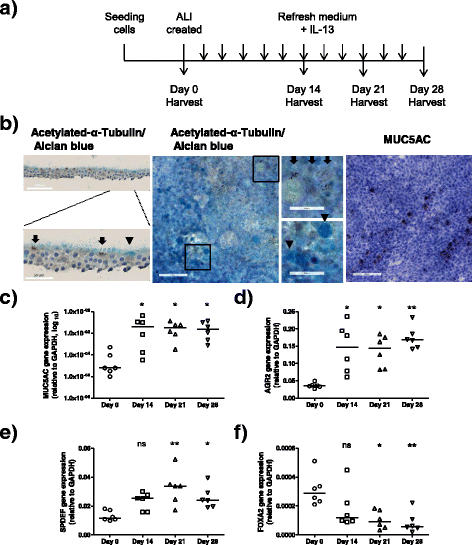Aberrant DNA methylation and expression of SPDEF and FOXA2 in airway epithelium of patients with COPD
- PMID: 28450970
- PMCID: PMC5404321
- DOI: 10.1186/s13148-017-0341-7
Aberrant DNA methylation and expression of SPDEF and FOXA2 in airway epithelium of patients with COPD
Abstract
Background: Goblet cell metaplasia, a common feature of chronic obstructive pulmonary disease (COPD), is associated with mucus hypersecretion which contributes to the morbidity and mortality among patients. Transcription factors SAM-pointed domain-containing Ets-like factor (SPDEF) and forkhead box protein A2 (FOXA2) regulate goblet cell differentiation. This study aimed to (1) investigate DNA methylation and expression of SPDEF and FOXA2 during goblet cell differentiation and (2) compare this in airway epithelial cells from patients with COPD and controls during mucociliary differentiation.
Methods: To assess DNA methylation and expression of SPDEF and FOXA2 during goblet cell differentiation, primary airway epithelial cells, isolated from trachea (non-COPD controls) and bronchial tissue (patients with COPD), were differentiated by culture at the air-liquid interface (ALI) in the presence of cytokine interleukin (IL)-13 to promote goblet cell differentiation.
Results: We found that SPDEF expression was induced during goblet cell differentiation, while FOXA2 expression was decreased. Importantly, CpG number 8 in the SPDEF promoter was hypermethylated upon differentiation, whereas DNA methylation of FOXA2 promoter was not changed. In the absence of IL-13, COPD-derived ALI-cultured cells displayed higher SPDEF expression than control-derived ALI cultures, whereas no difference was found for FOXA2 expression. This was accompanied with hypomethylation of CpG number 6 in the SPDEF promoter and also hypomethylation of CpG numbers 10 and 11 in the FOXA2 promoter.
Conclusions: These findings suggest that aberrant DNA methylation of SPDEF and FOXA2 is one of the factors underlying mucus hypersecretion in COPD, opening new avenues for epigenetic-based inhibition of mucus hypersecretion.
Keywords: COPD; DNA methylation; FOXA2; Mucus; SPDEF.
Figures





Similar articles
-
Tiotropium attenuates IL-13-induced goblet cell metaplasia of human airway epithelial cells.Thorax. 2015 Jul;70(7):668-76. doi: 10.1136/thoraxjnl-2014-205731. Epub 2015 May 20. Thorax. 2015. PMID: 25995156
-
miR-125b inhibits goblet cell differentiation in allergic airway inflammation by targeting SPDEF.Eur J Pharmacol. 2016 Jul 5;782:14-20. doi: 10.1016/j.ejphar.2016.04.044. Epub 2016 Apr 22. Eur J Pharmacol. 2016. PMID: 27112664
-
Corticosteroid and long-acting ß-agonist therapy reduces epithelial goblet cell metaplasia.Clin Exp Allergy. 2017 Dec;47(12):1534-1545. doi: 10.1111/cea.13015. Epub 2017 Sep 26. Clin Exp Allergy. 2017. PMID: 28833774
-
Regulation of mucin expression in respiratory diseases.Biochem Soc Trans. 2009 Aug;37(Pt 4):877-81. doi: 10.1042/BST0370877. Biochem Soc Trans. 2009. PMID: 19614611 Review.
-
The Potential Role and Regulatory Mechanisms of MUC5AC in Chronic Obstructive Pulmonary Disease.Molecules. 2020 Sep 27;25(19):4437. doi: 10.3390/molecules25194437. Molecules. 2020. PMID: 32992527 Free PMC article. Review.
Cited by
-
Advances in cancer DNA methylation analysis with methPLIER: use of non-negative matrix factorization and knowledge-based constraints to enhance biological interpretability.Exp Mol Med. 2024 Mar;56(3):646-655. doi: 10.1038/s12276-024-01173-7. Epub 2024 Mar 4. Exp Mol Med. 2024. PMID: 38433247 Free PMC article.
-
Building and Regenerating the Lung Cell by Cell.Physiol Rev. 2019 Jan 1;99(1):513-554. doi: 10.1152/physrev.00001.2018. Physiol Rev. 2019. PMID: 30427276 Free PMC article. Review.
-
Transcriptional Regulation of Airway Epithelial Cell Differentiation: Insights into the Notch Pathway and Beyond.Int J Mol Sci. 2023 Sep 30;24(19):14789. doi: 10.3390/ijms241914789. Int J Mol Sci. 2023. PMID: 37834236 Free PMC article. Review.
-
Overview of chromatin regulatory processes during surface ectodermal development and homeostasis.Dev Biol. 2024 Nov;515:30-45. doi: 10.1016/j.ydbio.2024.07.001. Epub 2024 Jul 4. Dev Biol. 2024. PMID: 38971398 Review.
-
Epigenetic impacts of maternal tobacco and e-vapour exposure on the offspring lung.Clin Epigenetics. 2019 Feb 19;11(1):32. doi: 10.1186/s13148-019-0631-3. Clin Epigenetics. 2019. PMID: 30782202 Free PMC article. Review.
References
Publication types
MeSH terms
Substances
LinkOut - more resources
Full Text Sources
Other Literature Sources
Medical

